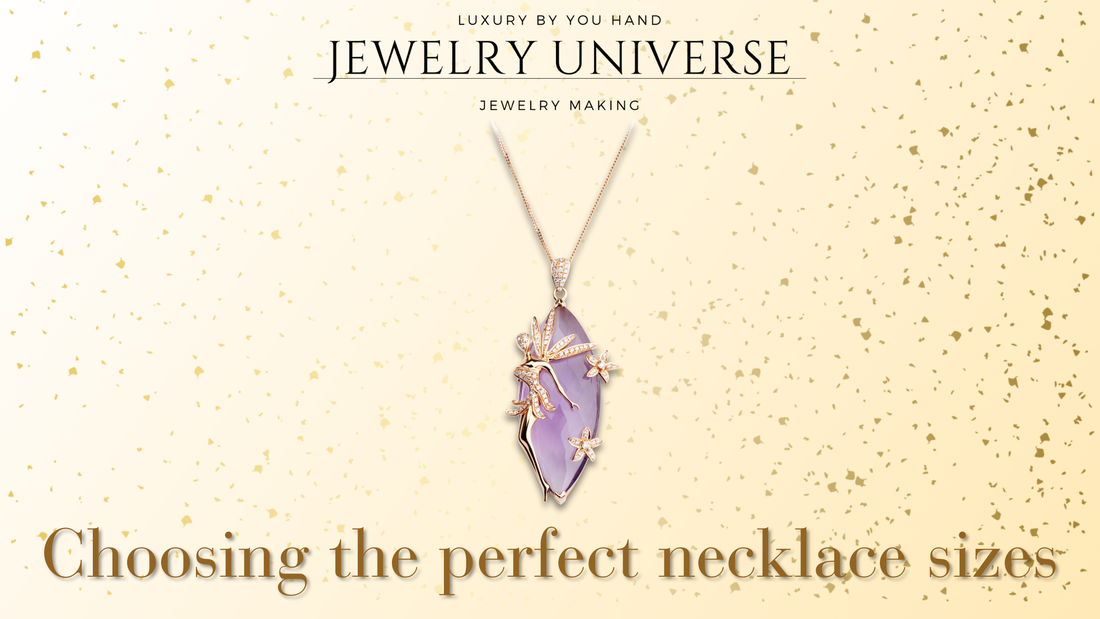
Choosing the perfect necklace sizes
Share
Selecting the right necklace size can significantly enhance your overall appearance and complement your outfit. Whether you're choosing a necklace for a casual outing, a formal event, or as a gift, understanding the nuances of necklace sizes ensures a perfect fit and optimal style. This article delves into the different necklace lengths, their meanings, how to measure for the ideal fit, and tips for pairing them with various necklines and outfits.
The Basics of Necklace Sizes
Standard Necklace Lengths
Necklaces come in a variety of standard lengths, each designed for specific styles and purposes. These include:
- Choker (14-16 inches): A choker sits tightly around the neck, offering a timeless and elegant look. It's ideal for high-neck outfits or as a statement piece.
- Princess (18 inches): This is the most common necklace length, resting at the collarbone and suitable for almost any neckline.
- Matinee (20-24 inches): A matinee necklace falls between the collarbone and the chest, providing a graceful and elongated effect.
- Opera (28-36 inches): Opera-length necklaces drape below the chest, exuding sophistication, especially when paired with formal attire.
- Rope (36+ inches): These long necklaces can be styled in multiple ways, including doubling around the neck or layering with shorter pieces.
The Importance of Fit
A well-fitted necklace not only enhances your look but also ensures comfort. The wrong size can feel restrictive or fail to highlight your neckline effectively. Understanding where a necklace will fall based on its length helps you visualize how it will interact with your body and clothing.
Choosing the Right Necklace Size for Your Neck
Measuring Your Neck
To find the perfect necklace size, start by measuring your neck using a soft measuring tape. Wrap the tape snugly around the base of your neck and note the measurement. Add two inches to this measurement for a comfortable choker length. For longer styles, consider how much you want the necklace to drape.
Accounting for Body Proportions
Your body proportions also play a role in determining the ideal necklace size. For example, individuals with longer necks can effortlessly wear chokers, while those with shorter necks may find longer necklaces more flattering as they create a vertical line.
Additionally, the size of your torso influences how necklaces of various lengths will appear. Petite frames may find shorter lengths more proportionate, whereas taller individuals can confidently wear longer styles.
Pairing Necklace Sizes with Necklines
High-Neck Outfits
For high-neck tops or dresses, opt for longer necklaces like matinee or opera lengths to add a focal point below the neckline. Rope necklaces can also work beautifully, especially when layered.
Low or Plunging Necklines
Shorter necklaces, such as chokers or princess-length designs, complement low-cut tops and dresses. These lengths accentuate the collarbone and frame the décolletage elegantly.
Collared Shirts
Collared shirts pair well with necklaces that sit just above the collarbone or longer pieces that rest below the first button. A princess-length necklace works well in most cases.
Popular Necklace Sizes for Different Occasions
Everyday Wear
For daily wear, a princess-length necklace offers versatility, effortlessly transitioning between casual and semi-formal settings. Simple chains or pendants in this size are timeless choices.
Formal Events
Opera and rope necklaces are ideal for formal occasions, as their length and elegance can elevate your ensemble. Pair them with evening gowns or sophisticated suits for a polished look.
Statement Pieces
If you're aiming to make a bold statement, consider chokers or oversized pendants at a princess or matinee length. These sizes draw attention to your neck and collarbone, adding drama to your outfit.
Necklace Sizes and Material Considerations
Metal Chains
When selecting metal chains, the weight of the material can influence comfort, especially for longer lengths. Ensure the clasp is sturdy and appropriately sized to support the necklace.
Beaded or Gemstone Necklaces
Gemstone necklaces may require slightly longer lengths to allow for movement and prevent discomfort. Be mindful of how the beads or stones interact with your skin and clothing.
Layering Necklaces
Layering involves combining necklaces of varying lengths to create a cohesive look. For example, a choker paired with a princess-length necklace and a matinee design creates a visually appealing cascade.
Trends in Necklace Sizes
Modern fashion trends often embrace versatility and personalization in necklace sizes. Adjustable chains are gaining popularity, allowing wearers to modify the length according to their outfit or mood. Layered necklaces have also become a staple, with combinations of chokers, princess-length, and matinee designs dominating contemporary styles.
Caring for Necklaces of Different Sizes
Maintaining the longevity of your necklaces requires proper care, regardless of their size. Store necklaces individually to prevent tangling, especially for longer designs like opera or rope lengths. Regularly clean metal chains and gemstone pieces to preserve their shine and avoid tarnishing.
Understanding necklace sizes is crucial for achieving the perfect balance of style and comfort. By familiarizing yourself with standard lengths, measuring accurately, and considering factors like necklines and body proportions, you can select necklaces that enhance your appearance for any occasion.
